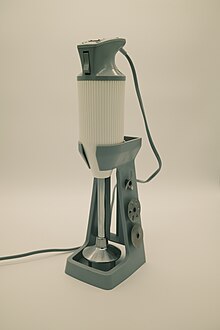| The topic of this article may not meet Misplaced Pages's notability guidelines for companies and organizations. Please help to demonstrate the notability of the topic by citing reliable secondary sources that are independent of the topic and provide significant coverage of it beyond a mere trivial mention. If notability cannot be shown, the article is likely to be merged, redirected, or deleted. Find sources: "Bamix" – news · newspapers · books · scholar · JSTOR (August 2022) (Learn how and when to remove this message) |
 | |
| Company type | Private |
|---|---|
| Industry | Small appliances |
| Founded | 1953; 72 years ago (1953) in Germany, 1954 as the Bamix brand |
| Founders | Werner Spingler Josef Gschwend |
| Headquarters | Mettlen, Switzerland |
| Area served | Worldwide |
| Key people | Martin Schmied, CEO |
| Products | Immersion blenders |
| Owners | Hans Jud Erich Eigenmann |
| Number of employees | 55 |
| Website | www.bamix.com |
ESGE AG, operating under the brand name Bamix (stylized bamix), is a Swiss company founded in 1953 that is active in the sector of electrical kitchen appliances. It is known for the Bamix, a hand-held blender which was invented by Roger Perrinjaquet, a Swiss engineer, and fully produced in Switzerland. ESGE AG also produces appliances which are co-branded. The models are Mono, Classic, DeLuxe, SwissLine, Superbox, Gastro, and SliceSy.
The company name, ESGE, comes from the initials of Spingler and Gschwend ("Es" and "Ge"), the founders of the original company, founded in Germany. Bamix is distributed worldwide in more than 40 countries with mainly exclusive distributors. In Germany, the company is marketed under the brand ESGE Zauberstab (English: "ESGE Magic Wand").
History

In 1950, the Swiss engineer Roger Perrinjaquet invented an appliance, which was patented on 6 March 1950 under the section handheld appliances. The application described the world's first stick (or wand) blender. His wish was to work with this appliance directly in pans on the stove. He called the new appliance Bamix, an abbreviation of the French words battre et mixer (English: beat and mix).
Without having investors, Perrinjaquet sold the patent rights in 1954 to ESGE Werner Spingler KG, founded in 1953, which was initially producing bicycle racks, electrical kitchen knives, watches and small electrical motors. By the end of the year, the company produced the first wand blenders. In 1957, the company changed its name to ESGE Gschwend + Spingler KG. The product range was expanded to include hand-held vacuum cleaners, citrus juicers, and toasters. At the end of the 1950s, the company launched the fabrication of the first handheld blenders in series. At the beginning of the 1960s, several production sites were opened, including the current head office of the company in Mettlen, in the canton Thurgau. During this period, the daily production amounted to 250 blenders. In 1963, sales of the Bamix completely collapsed in Germany. In 1964, the founders Spingler and Gschwend sold their company to the US conglomerate General Electric. The Americans planned to restructure the group and closed all production sites except the locations in Mettlen, Switzerland and Neuffen, Germany.
Despite improving sales figures beginning from 1967, General Electric decided to sell the company off in 1971. As the biggest buyer of Bamix food processors, Walter Bodart from Belgium purchased the production company in Switzerland with all rights for Bamix and ESGE Zauberstab, and introduced a strategy based on quality and a single product. ESGE AG in Mettlen became the only production site for Bamix. In 1983, the daily production reached 1,600 units. In 1986, Bodart agreed to a management buyout and sold ESGE AG to Valentin Gunsch (finance), Max Rüttimann (technology), and Werner Stahl (marketing). In 2002, Gunsch, Rüttimann, and Stahl sold the group to Hans Jud and Erich Eigenmann. Eigenmann served as CEO of ESGE AG from 1 October 2002. Since then the focus was on quality, branding and building up new markets to cover all relevant distribution channels in the markets. As of 2010, production capacity was 2,000 blenders per day. On 1 April 2019, Martin Schmied started as CEO of ESGE AG.
Since its invention, Bamix has changed rarely during the last decennium.
References
- ^ "bamix: Brilliantly simple. Simply brilliant" (PDF). ESGE AG. 2014. Retrieved 17 June 2021 – via Yumpu.com.
- ^ Griesser Kym, Thomas (13 March 2019). "Der Stabmixer hat noch Potenzial: Bamix holt neuen Chef an Bord". St. Galler Tagblatt (in German). Retrieved 16 June 2021.
- "Legal Notice". ESGE AG. Retrieved 17 June 2021.
- ^ "About us". ESGE AG. Retrieved 16 June 2021.
- "Electro Radio Mercuur, Nr. 247" (PDF). Electro Radio Mercuur (in Dutch). 16 April 1955. p. 227. Archived from the original (PDF) on 16 June 2021. Retrieved 17 June 2021.
- ^ "Geschichte". www.focusdynamics.de (in German). Archived from the original on 26 February 2016. Retrieved 16 June 2021.
- "Control of ESGE is Bought by G.E.; Swiss Housewares Maker's Stock Purchased for Cash". The New York Times. 3 June 1964. Retrieved 16 June 2021.
- "The spin on sticks," by Janice Matsumoto. Restaurants & Institutions, March 1, 2000.Vol.110, Issue 6, page 95.
- "A Whirling Dervish That Dips Right Into Your Pot," by Amanda Hesser. New York Times, August 19, 1998, page F.3.
- History of Bamix